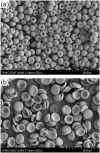Effect of osmolality on erythrocyte rheology and perfusion of an artificial microvascular network
- PMID: 25660474
- PMCID: PMC4361376
- DOI: 10.1016/j.mvr.2015.01.010
Effect of osmolality on erythrocyte rheology and perfusion of an artificial microvascular network
Abstract
Plasma sodium concentration is normally held within a narrow range. It may however vary greatly under pathophysiological conditions. Changes in osmolality lead to either swelling or shrinkage of red blood cells (RBCs). Here we investigated the influence of suspension osmolality on biophysical properties of RBCs and their ability to perfuse an artificial microvascular network (AMVN). Blood was drawn from healthy volunteers. RBC deformability was measured by osmotic gradient ektacytometry over a continuous range of osmolalities. Packed RBCs were suspended in NaCl solutions (0.45, 0.6, 0.9, 1.2, and 1.5 g/dL), resulting in supernatant osmolalities of 179 ± 4, 213 ± 1, 283 ± 2, 354 ± 3, and 423 ± 5 mOsm/kg H2O. Mean corpuscular volume (MCV) and mean corpuscular hemoglobin concentration (MCHC) were determined using centrifuged microhematocrit. RBC suspensions at constant cell numbers were used to measure viscosity at shear rates ranging from 0.11 to 69.5s(-1) and the perfusion rate of the AMVN. MCV was inversely and MCHC directly proportional to osmolality. RBC deformability was maximized at isosmotic conditions (290 mOsm/kg H2O) and markedly decreased by either hypo- or hyperosmolality. The optimum osmolality for RBC suspension viscosity was shifted toward hyperosmolality, while lower osmolalities increased suspension viscosity exponentially. However, the AMVN perfusion rate was maximized at 290 mOsm/kg H2O and changed by less than 10% over a wide range of osmolalities. These findings contribute to the basic understanding of blood flow in health and disease and may have significant implications for the management of osmotic homeostasis in clinical practice.
Keywords: Artificial microvascular network; Hyperosmolality; Hypo-osmolality; Microfluidics; Microvascular perfusion; Osmolality; Red blood cell deformability.
Copyright © 2015 Elsevier Inc. All rights reserved.
Figures






References
-
- Arieff AI. Hyponatremia, convulsions, respiratory arrest, and permanent brain damage after elective surgery in healthy women. The New England journal of medicine. 1986;314:1529–1535. - PubMed
-
- Kumar S, Berl T. Sodium. Lancet. 1998;352:220–228. - PubMed
-
- Klein L, O'Connor CM, Leimberger JD, Gattis-Stough W, Pina IL, Felker GM, Adams KF, Jr., Califf RM, Gheorghiade M, Investigators O-C. Lower serum sodium is associated with increased short-term mortality in hospitalized patients with worsening heart failure: results from the Outcomes of a Prospective Trial of Intravenous Milrinone for Exacerbations of Chronic Heart Failure (OPTIME-CHF) study. Circulation. 2005;111:2454–2460. - PubMed
Publication types
MeSH terms
Substances
Grants and funding
LinkOut - more resources
Full Text Sources
Other Literature Sources

